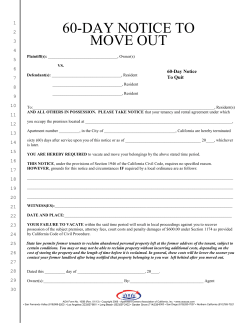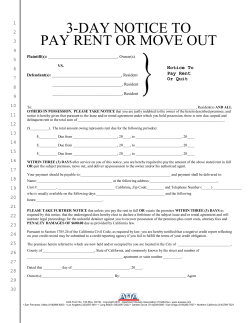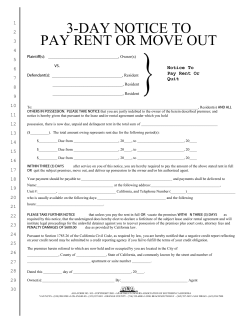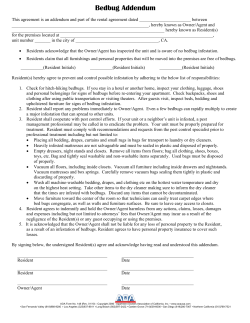
INDEX Bowel and Bladder Management program Sample forms
INDEX TAB ONE Bowel and Bladder Management program TAB TWO Sample forms - Assessments - Voiding Patterns and Re-training tools - QA Tools TAB THREE F-tag 315 Guidance to Surveyors and Investigative protocol. Manual includes: Program CD –Bowel and Bladder Management --includes entire program, protocol, and forms. PROCEDURES How to use this manual: All systems and processes have key steps or components that are needed to achieve the desired outcome. For a clinical program, the desired outcomes include: 1. Compliance with regulations and best practices. 2. Provides for individualized assessment and care planning. 3. Monitors effectiveness of processes in achieving desired resident outcomes. The QA Committee should review all outlined key components in this manual, then perform a gap analysis comparing current systems to recommended best practices recommended. SA M PL E Steps: 1. Evaluate current systems to key components outlined in this manual. 2. Define standards and key components for the health center. 3. Review F-tag 315 guidelines and protocols. Access clinical resources listed in guidance as a resource for developing procedures. 4. Use text from the manual provided on CD to develop center specific procedures. 5. Finalize forms. 6. Provide education and training to staff. 7. Implement systems. 8. Develop ongoing QA to monitor effectiveness. BLADDER CONTINENCE ASSESSMENT RESIDENT: ROOM: MEDICAL HISTORY * (over) MEDICATION HISTORY ** (over) MOBILITY 1 SLIGHTLY IMPAIRED Occasional confusion; some difficulty in new situations only 1 2 MODERATERLY IMPAIRED Frequently confused and disoriented; decisions poor; requires cues and supervision 2 3 SEVERELY IMPAIRED Continual confusion; decisions never or rarely made/ also includes comatose resident 3 or more ≤1 Group I No Group II, III 2 Group I; and/or 1 Group II; No Group III 3 Group I; and/or 2 Group II; and/or 1 Group III >3 Group I; and/or ≤ 3 Group II; and/or ≤ 2 Group III INDEPENDENT Fully ambulatory; self-sufficiency once in W/C; able to transfer to and from toilet LIMITED ASSISTANCE Ambulates with limited assistance (i.e. walker, cane) able to transfer to and from toilet with minimal assistance USUALLY / OCCASIONAL Incontinent ≤ 1 per week; and/or ≤ 2 per week, but not daily FAIR 1000 – 2000 cc daily EXTENSIVE ASSISTANCE Ambulates and transfers to and from toilet with moderate assistance DEPENDENT Non weight bearing; unable to transfer without full staff assistance FREQUENTLY Daily incontinence, but some control present INCONTINENT Inadequate control, multiple daily episodes No LIMITATIONS Alert, oriented x3 decisions consistent and reasonable None FLUID INTAKE GOOD ≤ 2000 cc daily SA BLADDER CONTROL STATUS CONTINENT Aware of need to void; includes foley POOR 500 – 1000 cc daily SIGNATURE EXTREMELY POOR < 500 cc daily TOTAL 0 – 3 = High restorative potential (retraining) 4 – 9 = Moderate restorative potential (habit/prompted) 10 – 14 =Low restorative potential (habit/prompted) 15 - 18 = Minimal restorative potential (Check Change) INTL SCORE E COGNITIVE STATUS 0 M PL CRITERIA DATE INITIAL INTL SIGNATURE INTL SIGNATURE SEE INSTRUCTION ON BACK Polaris Group (800) 275-6252 Page 1 of 2 COMPLETION OF THE BLADDER CONTINENCE ASSESSMENT 1. 2. 3. 4. The licensed nurse will evaluate each resident for each of the six criteria, determine the description that most closely approximates the condition of the resident, and record the numerical score in the scoring column at the far right. Add the scores from the criteria and enter the total in the spaces provided to determine the nursing interventions for each resident. The assessing nurse signs and dates the Bladder Continence Assessment. Using the total score, implement the nursing interventions according to the scale listed. 0–3= 4–9= 5. High restorative potential (retraining) Moderate restorative potential (habit/prompted) 10 – 14 =Low restorative potential (habit/prompted) 15 - 18 = Minimal restorative potential (CheckChange) The Bladder Continence Assessment form should be placed in the medical record upon completion. * MEDICAL HISTORY: Refers to medical conditions that affect the restorative potential of the resident. Examples below are not all inclusive: j. Other - SA d. Pulmonary e. Sensor/Perceptual f. Cognitive g. Psychiatric h. Endocrine i. Genitourinary - E c. Musculoskeletal - ASHD, CHF, Cardiac Dysrhythmia, HTN, PVD, CAD, Hypotension, Pacemaker CVA, MS, CP, Huntington’s Chorea, Parkinson’s Disease, Peripheral Neuropathy, Hemiplegia, Paraplegia, Quadriplegia, Hemiparesis, Seizure Disorder, Transient Ischemic Attach (TIA), Comatose, Aphasia Previous Fractures, Arthritis, Scoliosis, Pain, Skeletal Deformities, Kyphosis, Amputation (i.e. missing limb) Asthma, DOPD, Emphysema Balance Abnormality, Dizziness, vertigo, Glaucoma, Cataracts, Blindness, Hearing Loss Alzheimer’s Disease, Dementia other than Alzheimer’s Disease Depression, Anxiety Disorder, Manic Depressive (bipolar dx.) Psychosis, Neurosis Hypo/Hyperglycemia, Diabetes Mellitus, Hypo/Hyperthyroidism Vitamin B12 Deficiency, High BUN or Creatinine, Atrophic Vaginitis, Rule Out UTI, Rule Out Fecal Impaction, Rule Out Laxative Dependence, Cancer (i.e. Prostate), Hemorrhoids, Fissures/Fistulas, Rectal Bleeding Cancer (i.e. Brain), Explicit Terminal Prognosis M PL a. Cardiovascular b. Neurological - ** MEDICATION HISTORY: refers to medications that affect the restorative potential of the resident. Review 24 hour regularly administered (scheduled & prn) medications. Examples below are not all inclusive: GroupI a. Cardiac Lanoxin, Inderal, Procardia, Calan, Nitrobid, Transderm-Nitro, Lopressor b. Antihypertensive/Diuretic - Lasix, capoten, Dyazide, HCTZ, Diuril, Catapres, Tenorectic c. Sedative/HypnoticsSedative - Restoril, Halcion, Dalmane, Benadryl Group II a. Antidepressants/Antianxiety –Valium, Librium, Sinequan, Elavil, Ativan, Desyrel, Xanax, Ludiomil, Vistaril, Buspar Antivert, Dramamine, Compazine b. Anticholingerics Group III a. Antipsychotic/Neuroleptics - Mellaril, Haldol, Stelazine, Thorazine, Prolixin, Trilaforn, Navane b. Anticonvulsants/Neuromuscular – Phenobarbital, Artane, Dilantin, Moban, Tegretol, Depakene, Klonopin c. Anti-Parkinson Levodopa, Sinemet, Eldepryl, Permax, Parlodel, Cogentin Polaris Group (800) 275-6252 Page 2 of 2 PRELIMINARY NURSING ASSESSMENT Admit Date _____________ Admit time ______________ From _______________ Via __________________ Diagnosis __________________________________________ Allergies: ______________________________ T: ___________ P: ___________ R: ___________ BP: __________ HT: __________ WT: ______________ 1. COGNITIVE (CIRCLE) ALERT / ORIENTED TO: PERSON – PLACE – TIME MEMORY PROBLEMS / ACUTE CONFUSION / LETHARGIC / SEMI COMATOSE / COMATOSE: DESCRIBE __________________________________________ CARE PLAN Y OR N 2. MOOD AND BEHAVIOR (CIRCLE) ELOPEMENT POTENTIAL: Y or N __________________________ If yes, complete full Elopement Assessment tool E (Circle One) WITHDRAWN / PACING / VERBALLY ABUSIVE / CRYING / WEEPING / ANGRY / RESISTS CARE / M PL REPETITIVE BEHAVIORS / AGITATION/ OTHER: ____________________________________________________ CONDITION/DIAGNOSIS:_____________________________________________________CARE PLAN: Y OR N RECEIVING: HYPNOTIC / ANTIPSYCHOTIC / ANTIANXIETY / ANTIDEPRESSANT: LIST MEDS: _______________________________________________________________________________________ If applies: BEHAVIOR MONITOR INITIATED: _____ REFERRED TO PHARMACY: _____ 3. SA CONSENT SIGNED:_______SIDE EFFECT MON. STARTED:______ AIMS:__________ COMMUNICATION (CIRCLE) HOH / DEAF L R B HEARING AIDE L R B / OTHER: COMMUNICATES: SPEECH / GESTURES / WRITES / OTHER APHASIC CAN BE UNDERSTOOD Y OR N UNDERSTANDS Y OR N CARE PLAN: Y OR N 4. REFER TO THERAPY: Y OR N VISION (CIRCLE) ADEQUATE Y OR N GLASSES Y OR N BLIND Y OR N – L R B LENS IMPLANTS L R B PROSTHESIS L R B GLAUCOMA / CATARACTS / FIELD CUT L R B 5. CARE PLAN: Y OR N PAIN (CIRCLE) VERBAL OR NONVERBAL EXPRESSION OF PAIN: PAIN: Yes No CARE PLAN Y OR N COMPLETE PAIN SCREEN ON ALL RESIDENTS: IF SCORE IS GREATER THAN 3, COMPLETE FULL ASSESSMENT FORM.: Pain Screen Score: _______ Pain Scale: 1-10:_______ RESIDENT:__________________________________ RM:_______MR#________ Page 1 of 4 ELIMINATION ASSESSMENT SUMMARY Summary of risk factors, environmental. Functional/adaptive device needs, & voiding pattern data: Bladder Risk Score: ___ Type of Incontinence: Urge___ Stress___ Mix___ Overflow___ Functional___ Other___ Unknown___ Implement Bladder or Bowel retraining program: Remove Continue with Foley Catheter Justification: Infection Control in place: Fluid needs: Care Plan Completed M PL E Implement Intermittent Catheterization: Implement [] Prompted [] Habit [] Scheduled toileting training program as the individualization scheduled toileting plan for: Bladder Bowel OR Prior failed attempts at toileting schedules, implement Check and Change Describe toileting plan: Assessment completed by: _________________________________________ Date_______________ ELIMINATION ASSESSMENT SUMMARY SA Summary of risk factors, environmental. Functional/adaptive device needs, & voiding pattern data: Bladder Risk Score:___ Type of Incontinence: Urge___ Stress___ Mix___ Overflow___ Functional___ Other___ Unknown___ Implement Bladder or Bowel retraining program: Implement Intermittent Catheterization: Implement [] Prompted [] Habit [] Scheduled toileting training program as the individualization scheduled toileting plan for: Bladder Bowel OR Prior failed attempts at toileting schedules, implement Check and Change Describe toileting plan: Remove Continue with Foley Catheter - Justification: Infection Control in place: Fluid needs: Care Plan Completed Assessment completed by: _________________________________________ Date_______________ Resident_______________________ Med Rec_______ Physician_______________ Rm_____________ Polaris Group (813) 886-6500 Page 1 of 1 1. INTIAL/QUARTERLY ELIMINATION ASSESSMENT SUMMARY Summary of risk factors, environmental. Functional/adaptive device needs, & voiding pattern data: Bladder Risk Score: ___ Type of Incontinence: Urge___ Stress___ Mix___ Overflow___ Functional___ Other___ Unknown___ Implement Bladder or Bowel retraining program: Remove Continue with Foley Catheter Diagnosis: Infection Control precautions in place: Special Fluid needs: Care Plan revised/updated/current E Implement Intermittent Catheterization: Implement: [] Prompted [ ] Habit [] Scheduled toileting plan: Bladder Bowel Both Prior failed attempts at toileting schedules, implement Check and Change Describe plan: M PL Assessment completed by: _______________________________________ Date_______________ 2. QUARTERLY ELIMINATION ASSESSMENT SUMMARY Summary of risk factors, environmental. Functional/adaptive device needs, & voiding pattern data: Bladder Risk Score: ___ SA Type of Incontinence: Urge___ Stress___ Mix___ Overflow___ Functional___ Other___ Unknown___ Implement Bladder or Bowel retraining program: Implement Intermittent Catheterization: Implement: [] Prompted [ ] Habit [] Scheduled toileting plan: Bladder Bowel Both Prior failed attempts at toileting schedules, implement Check and Change Describe plan: Remove Continue with Foley Catheter Diagnosis: Infection Control precautions in place: Special Fluid needs: Care Plan revised/updated/current Assessment completed by: _______________________________________ Resident: _____________________________________ MR#:_________ Date_______________ Rm #: ______ Page 2 of 3 Page 1 of 2 CONTINENCE & CATHETER ASSESSMENT & RAP FACTORS POTENTIALLY related to CONTINENCE STATUS Bowel and Bladder Risk Score: _______________________________________ (Complete as part of RAI process and after Voiding Pattern Data Collection has occurred) Current DIAGNOSES Indicate MEDICATIONS currently taking: Antibiotics Disopyramide Diuretics Calcium channel blockers Antipsychotics Antianxiety Antispasmodics Antidepressants Antihistamines Hypnotics Narcotics Parkinsonism Antacids Drugs that stimulate or Stool softeners/laxatives block sympathetic nervous Antidiarrheals system Admit date: History of: Urinary disorders Prostate Problems Other (describe) Bladder disorders Neurological problems Pain Kidney disease U.T.I. Abnormal labs Edema No impairments impacting ability to toilet Impaired cognitive ability to use: Due to decline in: Impaired sensory ability to use: Due to decline in: Environmental factors: commode ROM transferability Fx cast need for adaptive device toilet commode bedpan/urinal call light ambulation bed mobility lighting balance use of restraints difficulty removing clothes E Due to decline in: toilet bedpan/urinal call light impaired memory comatose resistive to care refusal of care inability to remember toileting tasks M PL Impaired physical ability to use: toilet commode bedpan/urinal call light vision blind decline in communication skills hearing aphasic location of toilet location of commode lighting See RD Assessment regarding diet, fiber, fluid needs._______________________________________________________________________________ BOWEL ASSESSMENT SA (Complete at end of 3-day observation period) CONTINENT of STOOL: Yes No If incontinent: How long has resident been incontinent? _______________ Days Months Years Reason identified, if known: ___________________________________________________ Frequency of incontinence: Less than weekly Once a week 2-3 times a week All (or almost all) the time USUAL ELIMINATION PATTERN: Frequency: _______________________________________________ Time(s) of Day: Upon rising After meal(s): Bkfst Lunch Dinner No apparent pattern Other (describe): __________________________________________________ Amount: Small Med. Large Other: _________________ Perception of need to evacuate: Present Diminished Absent Prompting method: ________________________________________________________ History of impactions: No Yes, freq: ___________________ ________________________________________________________ Results of 3-day Observation: ________ % Continent Pattern: _________________________________________________ ________________________________________________________ ________________________________________________________ Resident Name ID# USUAL CONSISTENCY: Consistency: Hard Formed Soft Liquid Other: ____________ Color: Tarry Light/Medium Dark Brown Clay Other: _________ Flatulence: If known, caused by: ____________________________________________ Other (describe): _________________________________________________ Comments: _______________________________________________________________ ADDITIONAL PHYSICAL SYMPTOMS/PROBLEMS: Bowel Sounds: ________________________________________________ Comments: _____________________________________________________ ELIMINATION ASSISTS: None used Stool softeners, name, dose, freq: _________________________________ Laxatives, name, dose, freq: _____________________________________ Enemas, type, amount, freq: _____________________________________ Suppositories, type, amount, freq: ________________________________ Juice/Fiber, type, freq:__________________________________________ Comments: ______________________________________________________________ EXERCISE PATTERNS: Describe usual daily activities: _____________________________________ Is resident capable of increasing? Yes No, describe: ______________________________________________________________ Comments: ______________________________________________________________ ______________________________________________________________ Room # Physician FOLEY CATHETER ASSESSMENT AND MANAGEMENT Y (Yes) N (No) M PL E A resident is not to be catheterized unless his/her clinical condition demonstrated that catheterization was necessary. An indwelling catheter should only be used when there is a valid medical justification. In order to assess the need for catheterization the following questions need to be answered: Does the resident have a valid medical justification (supporting diagnosis) for use of the indwelling catheter? List:___________________________________________________ Does the resident have documented urinary retention that cannot be treated or corrected medically or surgically, for which alternative therapy is not feasible characterized by: [ ] Documented post void residual (PVR) volumes in a range over 200ml. [ ] Inability to manage the retention/incontinence with intermittent catherization; and [ ] Persistent overflow incontinence, symptomatic infections, and/or renal dysfunction Does the resident have supporting diagnostic testing or unsuccessful catheter-free trials documented? Does the resident have contamination of Stage 3 or 4 pressure ulcer with urine which has impeded healing, despite appropriate personal care for the incontinence? Does the resident have a terminal illness or severe impairment, which makes positioning or clothing changes uncomfortable or which is associated with intractable pain? If any of the above questions in this section are answered “yes”, then indwelling catheterization may be medically necessary if benefits outweigh risks. Re-evaluation should occur at least quarterly or at time of a symptomatic UTI. Catheter size: _____ SA Check the following practices: Y (Yes) N (No) Is the staff following the facility’s protocol and/or written procedures for catheterization? Do all personnel wash their hands before and after caring for the catheter/tubing/collecting bag ? Is staff securing catheter to minimize injury and positioning bag to decrease risk of infection? Is staff cleaning the catheter and providing bowel care per protocol? Fluid Needs addressed and met? SUMMARY: [ ] Remove catheter and initiate bladder program [ ] Continue indwelling catheter _________________________________________________________________________________________ _________________________________________________________________________________________ _________________________________________________________________________________________ _________________________________________________________________________________________ _________________________________________________________________________________________ RESIDENT: ______________________________________________________ ROOM: _______________ SIGNATURE: _____________________________________________________ DATE: _______________ Polaris Group (813) 886-6500 Page 1 of 1 Page 1 of 2 RESTORATIVE BOWEL AND/OR BLADDER RETRAINING PROGRAM RESIDENT: ROOM: MONTH: [ ] RETRAINING PROGRAM [ ] SCHEDULED TOILETING PROGRAM PROMPTED VOIDING PROGRAM [ ] BOWEL PROGRAM [ ] CATHETER REMOVAL/RETRAINING (PLACE A CHECKMARK IN THE BOX FOR THE APPROPRIATE PROGRAM) 2 3 4 5 6 7 8 9 10 11 12 1 2 3 4 5 DATE 7 8 9 10 11 12 1 p p p p p p p p p p M A A A A A A A A A A N p 1 YEAR: INITIAL (SIGN ON REVERSE) 6 A 11-7 7-3 3-11 E 2 3 6 7 8 9 10 11 12 SA 5 M PL 4 13 14 BLADDER PLAN: 1ST – 2ND Week: Check resident q2 hours, record code in boxes. Nurse circle hours that have established patterns. Toilet resident within one hour prior to circled times. 3rd–4th week: The length of time the resident has successfully delayed voiding will become the new established voiding pattern. Continue working with this patter until the resident is continent; usually 1-2 weeks. BOWEL PLAN: Determine individual bowel pattern; obtain physician order for reflex bowel training program. On 1st morning, examine rectum and remove any impaction. Completely evacuate rectum by suppository, enema or both. According to individual bowel patter, insert a suppository as ordered by physician 30 minutes prior to determined time of evacuation. After 15-30 minutes, or when resident has urge to defecate, place resident on toilet. If defection doesn’t occur, return resident to bed to check rectally. Progress is shown by repeated periods of continence; bowel reflex usually resumes by 3 weeks. CODES: S = TOILETED c SUCCESS L= LAXATIVE UI = URINARY INCONTINENCE BI = BOWEL INCONTINENCE W = TOILETED s SUCCESS UC = URINARY CONTINENCE BC = BOWEL CONTINENCE R = RESIDENT REFUSED SP = SUPPOSITORY E = ENEMA LG = LARGE M = MEDIUM SM= SMALL RESIDENT VOIDING PATTERN & HABIT/SCHEDULED TOILETING PLAN Goal: Circle One: Continent 100% of the time .Continent during waking hours .Occasionally incontinent (<3x in 24 hrs) IU= INCONTINENT URINE (Wet) (IB=Inc. Bowel) CU= CONTINENT URINE (CB=Cont. Bowel) CODE FOR EACH HOUR TO MEASURE SUCCESS OF PLAN 12 M 1 am 2 am 3 am 4 am 5 am 6 am 7 am 8 am 9 am 10 am 11 am 12 Noon 1 pm 2 pm 3 pm 4 pm 5 pm 6 pm 7 pm 8 pm 9 pm 10 pm 11 pm SA M PL E Date D=Dry Instructions: Resident is to be toileted = Upon Arising Before Meals After Meals At Bedtime ______ Toileting every two hours while awake ______ Toileting every one hour while awake Other (specify times) During the night at Intervals ______________ Devises Used (D-Day, E-Eve. N-Night): ____Commode at bedside___urinal___bedpan___toilet___Other______________________________ Other directions: _____________________________________________________________________________________________________ Fluid Needs:_________________________________________________________________________________________________________ RESIDENT NAME: Polaris Group (813) 886-6500 DOCTOR: ROOM#: Page 1 of 1 . BLADDER RETRAINING FLOWSHEET Residents Name: Room#: WEEK ONE: Record date. Initial in the appropriate box for each shift. Enter the code from the bottom in the box for the applicable MR#: time which best applies. Comments/Progress: 7-3 3-11 11-7 7 am 8 am 9 am 10 am 11 am 12 pm 1 pm 2 pm 3 pm 4 pm 5 pm 6 pm 7 pm 8 pm 9 pm 10 pm 11 pm 12 am 1 am 2 am 3 am 4 am 5 am 6 am 3 am 4 am 5 am 6 am M PL E Date / Init WEEK Two: Record date. Initial in the appropriate box for each shift. Enter the code from the bottom in the box for the applicable time which best applies. Comments/Progress: 7-3 3-11 11-7 7 am 8 am 9 am 10 am 11 am 12 pm 1 pm 2 pm 3 pm 4 pm 5 pm 6 pm 7 pm 8 pm 9 pm 10 pm 11 pm 12 am 1 am 2 am SA Date /Init CODES: U C B T Episode of urinary incontinence Resident found to be clean/dry Episode of bowel incontinence Toileted self/continent Polaris Group (813) 886-6500 A N W O Assisted to toilet with result Resident not cooperative Assisted to toilet without result Assisted to toilet with incontinent episodes Page 1 of 2 QA SCREEN Prevalence of Indwelling Catheter Threshold = 90% or greater Directions: Audit 100% of residents with Prevalence of Indwelling Catheter if flagged at the 90th % or greater. Y or X = Met NA = Not Applicable Medical Record/Room Number Criteria/Questions 2. 3. 4. 5. 6. MDS items that trigger QI and risk status are accurate for observation period Bowel and Bladder Assessment (RAP) upon admission, quarterly, and at time of change Bladder and bowel patterns collected for three days upon admission and at time of decline in continence Toileting plan documented: 1) Bladder/Bowel Retraining, 2) Scheduled Toileting, 3) Attends/diapers only, 4) Indwelling Catheter Care plan addresses fluid needs and bowel routine as indicated Care Plan addresses catheter care per facility policy E 1. Comments Observe provision of catheter care; infection control practices followed during care 8. Positioning of catheter in bed or chair maintains infection control best practices 9. Catheter and bag are covered to protect privacy per facility policy Indwelling Catheter: Documentation supports continued use of Indwelling catheter An indwelling catheter must be justified per regulations F315: 1. Urinary Retention that a) is causing persistent overflow incontinence, symptomatic infections, and/or renal dysfunction, b) Cannot be corrected surgically, c) Cannot be managed practically with intermittent catheter use. 2. Skin wounds, pressure sores or irritations that are being contaminated by urine 3. Terminal illness or severe impairment, which makes bed and clothing changes uncomfortable or disruptive. SYSTEM: QIs printed out monthly; review and investigate if flagged at the 90th % or greater SA M PL 7. Percentage of Compliance = # of Yes responses x100 Total #of blocks: )the # of audits x’s the # of questionsexclude System and NA questions) Assessor: Threshold Reached: Yes No Percentage of Compliance (# yes divided by # blocks = % compliance) Completed By: Polaris Group (813) 886-6500 Title: Date: Page 1 of 1
© Copyright 2025










